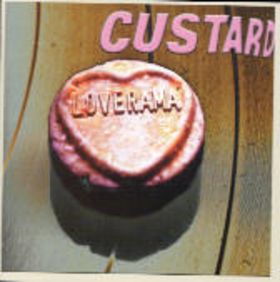Respect All Lifeforms is the eighth studio album by Australian alternative rock band Custard “Custard (band)”), released on 22 May 2020 by ABC Music.[1]
The album was preceded by the release of the single “Funky Again”, which was accompanied by a video directed by longtime collaborator Andrew Lancaster.[2]
Source: Respect All Lifeforms by Wikipedia
Gone are the days when the band would painstakingly labour over the creation of the album, the basis for Respect All Lifeforms, was recorded one weekend at Poons Head Studio in Fremantle while the band were in Perth to play a festival. As Dave McCormick explained:
“This album was pretty easy, we were about to fly over to Perth to play a festival, and we went over the day before because we hate the three hour time difference in Perth. You end up feeling like it’s 4am in the morning by the time you play.
“We had a day to kill, and Glenn Thompson booked us a studio in Fremantle, and we went in and we recorded eight songs on the day, and six of them we used on the album, so it was a productive morning.”
…
“We were less prepared than we normally are,” he explains. “Traditionally, Matthew Strong, guitar and I would get together and write, we’d show each other some chord ideas, send it around and everyone would have a listen and have a think about it.
“This session, no one had heard anything that any of us were working on, so it was all ‘first listen’, ‘what can we play?’ I didn’t even know what my songs were, really. I was thinking, ‘Maybe there’s a chorus here, a guitar solo’, but it was all very much a work in progress.
“I think this album is very immediate, and that’s the way I like working now. In the ’90s, we’d spend weeks and weeks on tracking the album, and mixing the album, but I don’t want to do that anymore. I just want to keep it all in a sense of falling forward where no one quite knows what’s happening, and I like that energy.”
Source: Custard: Still Full of Surprises by Tyler Jenke
While Glenn Thompson spoke about the spontaneity associated with learning and recording at the same time.
“We hadn’t played the songs before recording, so it was learning and recording at the same time – which is great. That spontaneity helps to make something interesting.
“We’ve played together for so long that there’s just a feeling, you know the direction in which things are going to go, and you all go in a similar direction at a similar time.”
Source: Custard’s ‘Respect All Lifeforms’ Is One Of The Best Albums Of 2020… Trust by Bronwyn Thompson
Discussing the album with Lindsay McDougall, McCormick explained that what makes a “Custard” song is when a song is played and the band hear it and add their additions in return, the organic interchange.
Respect All Lifeforms feels like a return to the ebbs and flows of We Have the Technology and Loverama. Unlike the last two albums, which opened with slower more somber tracks and a touch of country, this albums kicks off with a bang with ‘Couples Fight’, making something of a statement. The album then bounces around from there. Gone is the lap steel and harmonica. It does not wear the criticism of ‘Adult Contemporary’ made against their last two albums so well.
One interesting aspect about this album is that McCormick, Thompson and Paul Medew each take writing responsibilities. This itself brings a point of difference. With Thompson providing his usual infectious whimsical observations of the world with ‘A Cat Called No’ and ‘Wishing’, Medew providing some pace with ‘Wishing’ and ‘Like People’, while McCormick fills out the rest with his usual mix. They also provide a cover of Camper Van Beethoven’s ‘Taking the Skinheads Bowling’.
It was interesting reading David Lowery’s thoughts on writing ‘Taking the Skinheads Bowling’, in which he described it as “weird non-sensical”.
So it should not surprise you that I never thought that Take the Skinheads Bowling would become a Hit. If someone had traveled from the future and told me we would have a hit on our first album I would not have picked this song as being the hit. Not in a million years. I would have more likely picked Where the Hell is Bill.
Why? we regarded Take The Skinheads Bowling as just a weird non-sensical song. The lyrics were purposely structured so that it would be devoid of meaning. Each subsequent line would undermine any sort of meaning established by the last line. It was the early 80’s and all our peers were writing songs that were full of meaning. It was our way of rebelling. BTW this is the most important fact about this song. We wanted the words to lack any coherent meaning. There is no story or deeper insight that I can give you about this song.
Source: #74 Hits are Black Swans-Take the Skinheads Bowling by David Lowery
This is probably a good way of describing a lot of Custard’s music.
Noel Mengel argues that what makes a Custard album is the ebb and flow throughout.
But what is so enjoyable about Custard’s music is not that it can be defined in any neat way but that it can’t. Pop-rock with guitars it might be, but there is a lot going on that rewards play after play. And it always sounds just like them.
Source: Respect All Lifeforms. Custard by Noel Mengel
He also summarises the album as follows:
A lovers’ tiff, ills ancient and modern, great records past and present, the lengthening shadows of loves, record shops, hangovers: it’s all fuel for Custard.
Source: Respect All Lifeforms. Custard by Noel Mengel
On a side note, the picture on the cover was taken during the recording session in Fremantle of a man called ‘Cowboy John’:
“At this Poons Head Studio in Fremantle, there was this character called Cowboy John who was hanging around the studio,” he recalls. “He looked about, maybe [in his] 60s, and he was known to the studio owner.
“He came into the studio, hung out with us a little bit, and then he bummed some of Matthew’s cigarettes, and then he was gone. And as he left, he said, ‘Respect all lifeforms’, and that was it; he just walked out of the studio. And we just looked at each other and said, ‘That’s the album name, Respect All Lifeforms‘.
“And the studio owner, Rob [Grant], said ‘I’ve got a photo here of Cowboy John playing this monophonic Roland synth thing, and he’s wearing a crown.’ And we said, ‘We need that photo, that has to be the cover of the album.’
“So it was a productive morning. We had the album cover done, we had the title of the album done, and we had six songs recorded.”
Source: Custard: Still Full of Surprises by Tyler Jenke
Tracklist
Couples Fight
The last two albums started off with slower more subdued tracks. Couples Fight feels like something of a statement. It has a Ballroom Blitz feel, before breaking out the synthesiser. I am left wondering about categorising Custard’s songs, I think that this fits into the category of ‘observations’, especially with the line “playing Blood on the Tracks … via bluetooth.” It tells a story, but not a specific story.
Funky Again
I asked AI to create me a song that combines The Cure’s Let’s Go To Bed, Britany Spears’ Toxic and Fatboy Slim’s Weapon of Choice. It responded that the song already exists in the form of Funky Again. After listening to Dave McCormick on Take 5 podcast, I can hear the influence of Britany Spears’ Toxic in this track with some of the guitar lines, while it would be fascinating to hear Funky Again mashed up with Weapon of Choice.
Harrlequin Records
Category: biographical, maybe auto? Love the line, “I’m so dumb, people think that I am smart.” It has the big feel that was a part of the previous album.
A Cat Called No
Glenn Thompson has the ability to write the quirkiest songs with the most infectious harmonies.
Wishing
Paul Medew starts this song hard and drives it all the way through. It has an Elvis Costello feel.
Take the Skinheads Bowling
This is a cover of Camper Van Beethoven’s track. Here is David Lowery discussing the song:
So it should not surprise you that I never thought that Take the Skinheads Bowling would become a Hit. If someone had traveled from the future and told me we would have a hit on our first album I would not have picked this song as being the hit. Not in a million years. I would have more likely picked Where the Hell is Bill.
Why? we regarded Take The Skinheads Bowling as just a weird non-sensical song. The lyrics were purposely structured so that it would be devoid of meaning. Each subsequent line would undermine any sort of meaning established by the last line. It was the early 80’s and all our peers were writing songs that were full of meaning. It was our way of rebelling. BTW this is the most important fact about this song. We wanted the words to lack any coherent meaning. There is no story or deeper insight that I can give you about this song.
Source: #74 Hits are Black Swans-Take the Skinheads Bowling by David Lowery
It was interesting to go back and listen to the original track and another cover by the Manic Street Preachers. I think that Custard capture the quirkiness of the track and really make it there own. I saw that Adalita, Phil Jamieson, Tex Perkins and Tim Rogers are touring The Rolling Stones Sticky FIngers, it made me wonder if McCormick could actually front his own covers band, similar to Billie Joe Armstrong’s The Coverups.
The Min Min Lights
This is a story song that focuses on ‘Veronica’, but it does not make completely clear why she is crying. This song is story without all the information, instead it is about the emotion.
Talkative Town
Another song by Glenn Thompson. It contains Thompson’s penchant for passing comments on the world around (‘We live up in the trees, Or where they used to be’ and ‘I buy all my stuff with my digital thumbprint’) and society in general (‘I think there’s a more equitable system, I don’t think it’s called capitalism’) all on top of a bed of infectious pop.
Like People
Another song by Paul Medew about a relationship that we are brought in on. Moments are pieced together to place us in the situation of wanting things to change. As with Wishing, the song flies through.
Watcha Waiting For
We are ‘here’, but never quite sure where ‘here’ actually is. The ambiguous nature and slow feel of this song make it feel like it could have been the closing track for the album.
Come Tuesday
Category: (Auto)Biography
Come Tuesday is a reflective track from McCormick about life on the road. It touches upon how ‘come Tuesday’ everything can change. It is a slower more somber track and really closes off the album.








